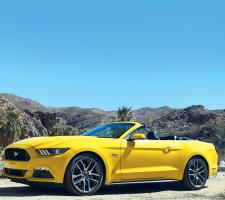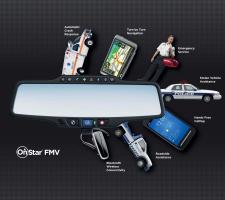
Growing consumer interest in car- and ride-sharing, as opposed to outright ownership, and ride-sharer Uber’s recently stated intention to make its brand competitive with ownership on cost, are making the major US automotive manufacturers think seriously about their future sales prospects. Some have already begun exploring ways of entering the field themselves, by developing their own solutions.
One ‘half-way house’ initiative enables people to share their own cars by renting them out during periods when otherwise they would be standing idle. This can be up to 90% of the time, given normal usage – 100% on days when vehicles are left parked at airports, clocking up daily charges.
Two major names, Ford and GM, have already tested the water with peer-to-peer (P2P) sharing initiatives, using smart technology effectively to create virtual rental fleets out of their customers’ privately-owned vehicles. Driving these moves are some sobering statistics from academic and business transportation experts.
Insurance
The issue of insurance for car-sharing drivers may be becoming less of a problem. New legislation in California is enabling them to rent out their cars without invalidating their existing motor insurance – a move that will give a further boost to car-sharing as other US states follow suit. Existing services will also be able painlessly to expand their fleets by allowing private owners to join their schemes
Professor Susan Shaheen, co-director of the Transportation Sustainability Research Center at the University of California at Berkeley, calculates that each vehicle bought by an operator for full-time sharing replaces between four and six new car sales to individual drivers, and can postpone a purchase by as much as five years. She estimates that around one million Americans are already car-sharers.
In February 2014
Groundbreakers
In June 2015, Ford announced a pioneering offer of a P2P deal to an invited cross section of its customers who are financing their new purchase through the Ford Motor Credit scheme. Operated jointly with San Francisco-based rent-out start-upPrescreened drivers
It runs until end-November 2015, after which participants will be able to continue car-sharing if they wish. The deal offers owners a prescreened database of drivers who will pay to use their cars, plus insurance if necessary (see box).Getaround has built its business by offering on-demand hourly rentals. On its website, the company claims that owners can earn up to US$6,000 net a year, depending on the location, after its 40% commission. It requires the vehicle to be model year 2005 or later, have fewer than 200,000km on the clock, be available for specified numbers of days per month and be rented out at a rate within 20% of Getaround’s recommended figure.
Owners provide pickup and return instructions, with details of parking available, which are sent privately to the renter. In their web listings, owners can impose ‘etiquette’ rules, for example, no pets or smoking, and levy penalties for breaches.
Getaround collects the owner’s car for installation of its electronic Connect device which allows renters keyless access to vehicles through its mobile app and incorporates GPS-based tracking to enable location of vehicles by both owners and prospective renters. Fitting costs US$99, plus a monthly rental fee of US$20.
Renters download the Getaround app to set up an account, browse available cars and enter their driver’s licence and bank card details. They use their smartphones to unlock their chosen vehicles.
Asked whether a new branded product, combining a sale with entry to the alternative rental market, could be on the horizon, a spokesperson for Ford Motor Credit told ITS International: “The results of this pilot will help inform our business decisions for the future.”
Ford has already partnered Cambridge, Massachusetts-based car-share group Zipcar in providing low-cost and fuel-efficient Focus sedans and Escape sport utility vehicles for students on college and university campuses across the US, as a way of introducing its products to younger drivers. It hopes that some will decide to go on to buy.
Car rental
The Ford initiative comes despite the earlier short-lived partnership between General Motors and San Francisco-based start-upOperated by GM subsidiary the OnStar Corporation, the in-vehicle system connects millions of customers and delivers them a range of communications, security, hands-free phoning, navigation, remote diagnostics and emergency alert services. The attraction of the P2P scheme was that all equipped vehicles were immediately ready for the service, without the need for additional hardware whereas unequipped ones needed the installation of an in-vehicle device to deliver the necessary connectivity.
RelayRides, which claims to have pioneered P2P car sharing in the US, was the first third-party developer to integrate OnStar’s proprietary application program interface when this became available. “Unfortunately,” GM spokesman Stuart Fowle told ITS International, “the relationship ended in 2013 after RelayRides changed its focus to a longer-term rental model”.
GM can offer no figures on how well the scheme went. It has no current alternatives under consideration “in the car-sharing space”, but according to Fowle it is deploying OnStar for additional fleet management purposes.
In a parallel development, car owners driving to catch a plane can avoid paying airport parking charges and earn some income by letting a company such as RelayRides rent out their vehicles during their absence. Renters can pay as little as 40% of the standard charge.
This could, however, have a financial downside for airports. A recent survey by the Virginia, US-based International Parking Institute shows that parking and ground transportation provide some US$2.9bn of annual revenue to American and Canadian airports.
Meanwhile, other US automakers are establishing a growing presence in the shared mobility, says Shaheen. She instances models of one-way car-sharing, such as those offered by car2go (Daimler, with its SmartFortwo vehicles) and DriveNow (BMW, with its electric BMW i3s), that direct app-equipped renters to pre-positioned parked vehicles in dedicated locations.
Fractional ownership
She also detects moves towards fractional ownership, in which individuals would subscribe to use a vehicle owned by third party – a concept already established for assets such as high-value private planes or yachts, and holiday properties through timesharing. “There appears to be an evolving norm where automakers are involved in shared mobility as a service, in addition to auto production,” she adds. In turn the US$20.55bn conventional car rental business, with a total fleet estimated at over 1.6 million vehicles, is feeling the impact of the new manifestations of shared mobility. Says Shaheen: “We have been seeing the convergence of the car-sharing and rental car markets for some time.”She points to the emergence of internet-based cashier-less and cashless rental transactions, and ‘virtual storefronts’ from which renters can choose a specific car - for periods from hourly to weekly - for reserved or spontaneous, one-way or round trips.
Mark Wakefield, who leads AlixPartners’ US automotive group, highlights some of the challenges faced by car-sharing concerns contemplating competing with the rental market. One is the management of fleets in the field, and engagement with customers such as municipalities and universities.
Another is the typical behaviour of traditional renters, “who, shall we say, are not exactly known for their great upkeep of cars or paying a lot for them. But car-sharing could, perhaps, present a whole new model to the car-renting business – if the industry can handle it correctly.”
Business users
Business car-sharing, aimed at enabling corporate organisations to reduce or dispense entirely with their car fleets, is also spreading in the US. Most major car-sharing companies across North America offer it as an option for company clients and, in a July 2015 information brief from the Transportation Sustainability Research Center TSRC, Shaheen suggests that this market sector is becoming more profitable for operators.Among clients, large companies are attracted to an alternative to the high overhead and maintenance costs of running their own fleets. SMEs can find themselves burdened with the administrative reimbursement and insurance issues of employees using their own cars for company purposes. “Business car-sharing has helped meet these market demands by providing on-demand mobility to companies at a competitive cost compared to fleet ownership and traditional rental,” she says.
Ride-sharing
Lyft and Uber, whose schemes use online networks to turn private cars into virtual taxis that can be hailed by smartphone, dominate the US ride-sharing market. Their largely similar services and apps for sending journey requests to enrolled drivers - though Uber is ahead in terms of global expansion. By May 2015, its service was available in 58 countries and 300 cities worldwide. Users can track the car’s progress on a map until it arrives and all payments are cashless – automatically transferred by bank card via the app at the end of the journey.In the US (and elsewhere), such schemes remain controversial. One reason given is ‘unfair’ competition with licenced taxi services who, in the US, pay heavy ‘medallion’ premiums for the right to operate, which are naturally reflected in the fare rates.
Another is that ride-sharing companies levy algorithm-generated ‘surge pricing’ at times of high demand. The operators argue that this encourages more drivers to come online and be available when needed; but they have responded with decisions to cap fares during disasters and emergencies, or offer ‘happy hours’ at times of low demand.
In his challenge to US automakers, Uber CEO Travis Kalanick says that competitive pricing against vehicle ownership “is integral to the future. Uber doesn’t grow if we’re more expensive than car ownership”. Supporting his stance is Los Angeles-based entrepreneur Kyle Hill who calculated in August 2014 that using Uber exclusively would be cheaper than owning a standard, medium-bracket car for anyone travelling fewer than 15,170km per year.
Since 2014 both companies - together with another operator, Sidecar – have also been offering car-pooling (often termed ‘ride-sharing’ in Europe). This matches passengers travelling in the same direction – a travel mode which had previously been steady declining in the US since the 1970s.
In a further move that could have far-reaching implications for the automotive industry, Uber has announced a partnership with Pennsylvania’s Carnegie Mellon University to establish the Uber Advanced Technologies Center. In the first instance, this will enable the company to work on mapping and safety technologies aimed at creating an improved dispatch and routing system which could help meet regulators’ and users’ concerns.
It will also give Uber access to the university’s National Robotics Engineering Centre, which would allow the company to investigate the automated vehicle sector and the potential for establishing its own fleet of autonomous cars. The company could even, some analysts have suggested, go on to develop an aftermarket solution for adding the necessary capabilities to existing vehicles.
Asked by ITS International for his advice to US automakers facing growing competition from new directions such as car-sharing, AlixPartners' MarkWakefield replied: “In four words; participate rather than fight“. His suggestions include:
• Tailoring variants of popular models for car-sharing.
• Organising access to dealers for maintenance and other services.
• Extending mobility guarantees to car-sharing vehicles.
• Leveraging technology including ITS, social media (for example, for communication between owners and renters) and in-vehicle connectivity 'hotspots', and taking on the role of the 'integrated mobility provider'.
• Repackaging ownership costs by, for example, offering prepaid service plans which increase cost predictability for owners and renters.
• Enhancing proactive maintenance through telematics.










